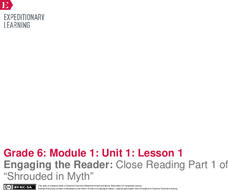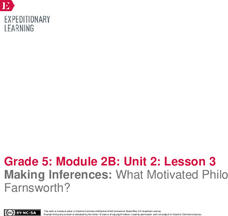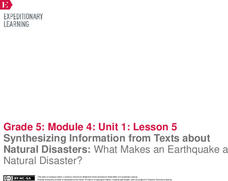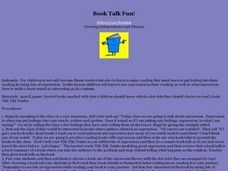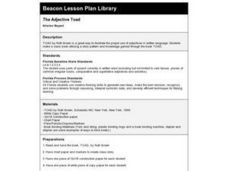EngageNY
Analyzing Text Structure: “Water Is Life” Paragraphs
Water, water everywhere. Readers revisit paragraphs six through nine in the article "Water is Life" to answer text-dependent questions. They then pair up to reread the article focusing on its structure and record their thoughts on...
EngageNY
Engaging the Reader: Close Reading Part 1 of “Shrouded in Myth”
Read and reread for better understanding. Scholars listen to a read aloud of Shrouded in Myth. They talk with a partner about the things they noticed and wondered about the text. They then listen to the text a second time to focus on the...
EngageNY
Informational Text Features: Analyzing “Hawaii’s Endangered Happy Face Spider”
Some things are better the second time around. Scholars reread an article about Hawaii's happy face spider, answering text-dependent questions as they read. Then, they use a Venn diagram to compare the text features of interviews and...
EngageNY
Reading Informational Text for Details: Meg’s Rainforest Experiment (Pages 17–20)
Take good notes. Scholars record information in their note catcher sheets as the teacher reads aloud pages 17-20 of The Most Beautiful Roof in the World. Learners then reread parts of the text in groups and rotate to share the notes they...
EngageNY
Making Inferences: What Motivated Philo Farnsworth?
Turn on the tube. Learners take a look at pages 10-13 of The Boy Who Invented TV. They work in groups and complete a first read to determine the gist of the section. They then reread the pages to make and revise previous inferences and...
EngageNY
Synthesizing Information from Texts about Natural Disasters: What Makes an Earthquake a Natural Disaster?
Are all disasters natural? Scholars reread Earthquakes! to determine what classifies these events as a natural disaster. They label earthquake facts as N for natural or D disaster to support their ideas. They then discuss academic...
K20 LEARN
Considering "Charles": Pictograms, Annotations, Reading Strategies, And Multimodal Responses
Shirley Jackson's short story, "Charles," provides middle schoolers with an opportunity to practice their close reading skills. Using the provided list of prompts, scholars read and reread the story, then create a multimodal response to...
PBS
Dr. Martin Luther King Jr.’s ‘I Have a Dream’ Speech as Visual Text
Young historians watch a video of Dr. Martin Luther King Jr. delivering his "I Have a Dream" speech and answer questions that test their knowledge of the event. After discussing the fact sheet, they reread the speech, select a phrase or...
Curated OER
Language Arts: Writing Through Reading
Improve writing skills using methods from Robert Gay's Writing Through Reading; Gay espouses reproducing the work of successful writers to build the ability to convey original ideas effectively. Young writers transcribe, paraphrase, and...
Curated OER
Introduce: Comprehension Monitoring using About Trees
As scholars begin reading more difficult text, they need to acquire an arsenal of comprehension strategies. Here are few helpful ones to guide new readers through the informational text About Trees, which is linked here for printing....
Curated OER
Fairy Tales Retold
Students use writing processes effectively to adapt and retell stories. They reread a favorite fairy tale, then adapt and retell in a PowerPoint or other multimedia presentation. They present their rewritten and edited presentations to...
Curated OER
Writing a Summary
Skim, reread, and then take notes. The step-by-step procedure outlined in this resource can be used to help pupils write a summary of a reading passage. Using their notes, class members then draft a summary focusing on the main idea and...
Curated OER
Understanding Connotation
Lincoln's "Gettysburg Address," which is available online, is used in the language lesson presented here. Middle schoolers read through the text for comprehension. Then, they reread the first paragraph and identify all the words with...
Curated OER
The Cinder-Eyed Cats - Storybook Theater
The students listen to the story "The Cinder-Eyed Cats." The students then chose individual parts to play in a theater like production. The students move like their character, be it a fish, an octopus, a lobster, a cat, etc. Water music...
Curated OER
Book Talk Fun!: Growing Independence and Fluency
Master reading fluently and with emotion and expression! Young learners read and reread the book Tiki Tiki Tembo by Arlene Mosel to practice this strategy. The remark on the end punctuation to help them decide how to read the sentence.
Curated OER
Narratives
Add to the narrative writing experience. Elementary or middle school writers listen to the teacher read a descriptive passage, then reread the same passage silently. They highlight sensory details and figurative language, then orally...
Curated OER
Ready to Race
Students practice techniques to help them be able to read faster, smoother and with expression. They read and reread a text in order to become more familiar with the words in the passage. Each student is given a copy of "Caps for Sale,"...
Curated OER
Rain
First graders practice oral and silent reading using beginning comprehension and decoding strategies. In this guided reading lesson, 1st graders take a picture walk and make plot predictions prior to reading the book Rain by Robert...
Curated OER
Hattie and the Fox
Who is Hattie? Youngsters explore animal characteristics by reading poems and stories in class. They read the book Hattie and the Fox about a fictitious fox and his drama with the other farm animals. Then they reread the story over...
La Jolla High School
Of Mice and Men by John Steinbeck: Who Said This?
Can your class figure out who said what just by looking at a quotation? This activity for Of Mice and Men includes 11 quotations from the novel. Use this quote sheet as a light activity to get your readers to look back into the text or...
Curated OER
The Adjective Toad
Students listen to the story Toad, then the story is reread without any adjectives. The class discusses the importance of details in a story. Then the class creates a collaborative book following the same story pattern.
Curated OER
"Faster, Faster, Red Riding Hood!"
Students practice becoming fluent readers by recognizing words accurately, rapidly and automatically. They read and reread the book, "Red Riding Hood," by James Marshall and "Frog and Toad Together," from Scholastic, in pairs and with a...
Curated OER
Express Yourself!
Students practice the strategy of reading fluently with expression with the story "Who took the Cookies from the Cookie Jar?" They read and reread the story utilizing different strategies when stuck on a word. Students practice whole...
Curated OER
A Troublesome Portage
In this portage worksheet, students read a 1 page article on a troublesome portage, find the 5 words listed in the paragraph indicated, label each words part of speech and then define each word. Students imagine they are one of the men...
Other popular searches
- Repeated Reading
- Rereading
- Scarlet Letter Rereading
- Repeated Reading Passages
- The Scarlet Letter Rereading
- Rereading Texts
- Rereading Love That Dog
- Fluency Repeated Reading
- Rereading Strategies
- Rereading Activities
- Repeated Reading Poems
- Repeated Reading Graph



